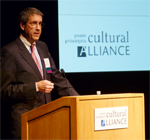 Eric Fraint addresses the GPCA audience When economic times are hard, government leaders frequently see “discretionary” funding for arts and cultural organizations as one of the first line items to be cut from municipal, county and state budgets. In a number of cities across the U.S., however, leaders of these nonprofits have found an effective way to counter budgetary cutbacks by detailing the positive economic impacts of the arts. In the case of Philadelphia, the impact is nothing short of spectacular.
The study found that cultural activity generates $169 million in annual state and local tax revenues and supports 43,700 jobs within the city and four suburban counties. The sector triggers $3.3 billion in direct and indirect expenditures every year, including $1.04 billion in 345 organizations’ employee paychecks and other household income. Ancillary spending by audiences – such as overnight lodging, transportation, meals before and after events, catering, concessions, souvenirs, gift shops and event-related child care – exceed $1.4 billion. Indirect expenses generate another $1.9 billion that ripple through the economy, said GPCA President Tom Kaiden. Kaiden put the impact of $1.04 billion in household income into terms that any Philadelphian could understand: it is enough, he said, to buy 129,966,625 cheesesteaks, or more than 32 cheesesteaks for every resident of Southeastern Pennsylvania! (In more serious – and perhaps healthier – terms, $1.04 billion would also buy a year’s worth of groceries for 281,000 families, clothing for 572,000 families, or gas for 577,000 families.) Nationally, among 181 other communities, only the Washington, D.C. region saw more expenditures from the arts and culture sector, and no region in the U.S. came close to matching Philadelphia in terms of job creation originating with arts and cultural institutions. The impact on job creation was the most notable: not only did the 43,700 jobs created far outpace the second-place region (greater Houston with 29,100 jobs), but Southeastern Pennsylvania’s rate of 10.9 jobs generated per 1,000 residents far exceeded any other metropolitan areas and was double the national average, further contributing to the vibrant tradition and competitive advantage of the region. The impact on tourism was seen as highly significant: 38% of out-of-town visitors stayed overnight to attend cultural attractions, and 70% said they would not have come to the region had it not been for the arts and culture opportunities. “The cultural sector is a significant economic driver, pumping billions into local economies, neighborhoods and paychecks. Working together, we can ensure that arts and culture is viewed as an investment, not an amenity, and that Greater Philadelphia is universally recognized as a world-class region defined by its rich and vibrant cultural life,” Kaiden said. Individual nonprofits are encouraged to share this report with their boards and staffs, and to use GPCA’s online impact calculator to compute their own economic analyses. By being active advocates and sharing these data with elected officials, government leaders can see the significance of the arts above and beyond improving the aesthetic quality of life of a region. Marrying these data with personal stories can make for even more effective presentations, Kaiden said. “Arts and culture are a civic investment and a revenue generator, not a drain, on government spending. They are a public good, and nonprofit staffs, boards and volunteers working in this area are providing a gift to every citizen of this region,” said Eric Fraint, President and Founder of YPTC and a member of GPCA’s Board of Directors. 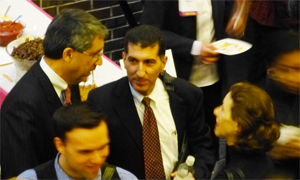 While delicious catered food was being served at the reception, Eric Fraint took time to meet with many of the GPCA participants. The 2012 study was the second such economic impact report produced by GPCA, and is a descendant of Your Part-Time Controller’s pioneering Pennsylvania Cultural Data Project (CDP), which was initiated in September, 2004 and subsequently expanded nationally. Fraint noted that the CDP is a unique collaborative system that enables arts and cultural organizations to benchmark their progress through access to reliable, comprehensive data and to make a better case for the arts to policy makers. Through the CDP, which YPTC helped develop in collaboration with the Pew Charitable Trusts, nonprofit leaders can enter fiscal, programmatic and operational data into a standardized online form. The results produce reports that can help increase nonprofits’ management capacity, identify strengths and challenges, inform decision-making, and compare themselves against comparable organizations. The reports are valuable tools for self-analysis, enhance presentations to potential funders, and help nonprofits make a better case for the arts and culture. The impact of museums, historic sites, dance companies, music ensembles and other cultural attractions is part of a broader picture first described in a 2005 report from the Johns Hopkins University Center for Civil Society Studies. That study reported that the nonprofit sector is a major economic force in Pennsylvania, accounting for one out of every nine paid workers and a striking 27% of all private employment in Philadelphia and 15% of all private employment throughout the five-county Philadelphia region. |
 The YPTC booth was a beehive of activity as several hundred attendees filled the lobby of the Annenberg Center for the Performing Arts. Excerpted Comments from the
Greater Philadelphia Cultural Alliance’s 2012 Annual Meeting September 24, 2012 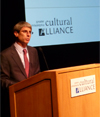 Tom Kaiden “I’d like to introduce the co-sponsor of tonight’s Annual Meeting, Eric Fraint, President of Your Part Time Controller. As many of you know, YPTC has been a key partner and counselor of the Alliance for the past dozen years. And it’s not just the Alliance, I know that Eric, Jennifer and their team have been vital partners in so many of your organizations as well. “In fact, a few years ago, when the capitalization study, “Getting Beyond Breakeven” came out, it reported relatively high levels of financial literacy in the Philadelphia region despite low levels of dedicated financial staff. At the time, the report authors suggested that that was likely a result of YPTC’s presence in the market. Well, now I think you’re going to see those financial literacy numbers starting to go up all along the Eastern Seaboard, because YPTC has expanded to Washington, D.C. and New York. “I am also pleased to note that next year marks YPTC’s 20th year anniversary. Please join me in congratulating and welcoming our partner, board member and tonight’s co-sponsor, Eric Fraint.” — Tom Kaiden, President
Greater Philadelphia Cultural Alliance 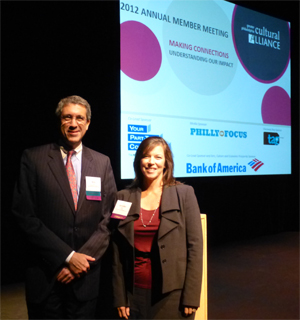 Eric Fraint and Your Part-Time Controller Partner Jennifer Alleva were among several YPTC representatives who attended the GPCA Annual Meeting . “Tom mentioned that our 20th year anniversary is coming up. Anniversaries are a time to reflect on the past and to say thank you to people who have been supporters of ours over the years. Tonight I want to say thank you to some very important people in my professional life, some of whom are here in the audience tonight. “Back in March of 1993, I started Your Part-Time Controller working alone out of my house. I picked up a little work here and there.
“Then, one morning in December of that year, I received a phone call which changed my life.“The call was about a small house museum called The Rosenbach Museum & Library. The then-executive director, Stephen Urice, was having problems getting accurate, timely, monthly financial reports from his accounting department. Not knowing what to do, he called his friend Tim Murray for advice. Tim, at that time, was the number one financial person at the Pew Charitable Trusts. Not knowing who to call, Tim asked Hank Bernstein, the then-number two financial person at Pew. Hank called me. “The Rosenbach was my first nonprofit client, and 20 years later they are still a client. I want to thank you Stephen, Tim, and Hank for that phone call which has blossomed into my vocation and my avocation. And thank you to Derick Dreher, who has been the executive director at the Rosenbach for the last 14 years. “Another milestone project for our firm was the Cultural Data Project. The CDP, starting here in Philadelphia and now spreading across the country, has become a wealth of valuable information. You will hear more about new research findings coming from the CDP in just a few minutes. “My involvement with CDP started over a lunch I had many years ago with Greg Rowe, director of culture initiatives and deputy director of the Philadelphia Program at Pew. I, by chance, mentioned to Greg that we were trying to collect comparative information about arts organizations from their 990’s. Greg’s jaw dropped and he told me that a group of funders were thinking of doing something very similar. Thus began the project for me and YPTC, after a chance encounter over lunch, to help build CDP. Thank you, Greg, for this opportunity. “Through that project I came to meet many wonderful people. Among them are Philip Horn and Brian Rogers at the Pennsylvania Council on the Arts; Bobbie Lippman and Marion Godfrey at Pew; Olive Mosier and Courtney Wilson at the William Penn Foundation; and, of course, the late Peggy Amsterdam. Thank you Philip, Brian, Bobbie, Marion, Olive, Courtney, and Peggy, may you rest in peace, for the opportunity to work on such a fabulous project. “I have many others to thank, but I am out of time. I will be thanking many more people during our anniversary year in person and on my blog. You can find my blog at www.EricYPTC.com. Click the “Follow” button and you will be alerted when new blogs are posted. “Before I finish, I have one more person to thank, my business partner Jennifer Alleva. Jennifer, please stand up. “Thank you all for coming and enjoy the rest of the evening.” — Eric Fraint, President and Founder,
Your Part-Time Controller Member, Board of Directors, Greater Philadelphia Cultural Alliance |
What’s the Economic Impact of Nonprofit Arts Organizations?



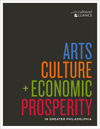 The
The 



